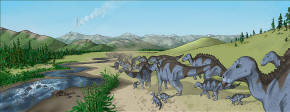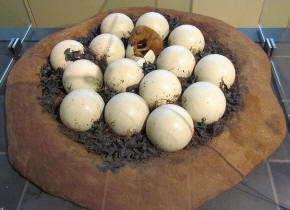|
Discovery
Maiasaura
was discovered by Laurie Trexler and described by dinosaur paleontologist
Jack Horner
(paleontologic advisor for the
Jurassic Park movies)
and Robert Makela. He named the dinosaur after Marion Brandvold's discovery
of a nest with remains of eggshells and babies too large to be hatchlings.
These discoveries led to others, and the area became known as "Egg
Mountain", in rocks of the
Two Medicine Formation
near Choteau in western
Montana. This was the first proof of giant dinosaurs raising and feeding
their young. Over 200 specimens, in all age ranges, have been found. The
announcement of Maiasaura's discovery attracted renewed scientific interest
to the Two Medicine Formation
and many other new kinds of dinosaurs were discovered as a result of the
increased attention. Choteau
Maiasaura
remains are found in higher strata than their Two Medicine River
counterparts.
Nesting
Maiasaura
lived in herds and it raised its young in nesting colonies. The nests in the colonies were packed closely together, like those of modern seabirds, with
the gap between the nests being around 7 metres (23 ft); less than the
length of the adult animal. The nests were made of earth and contained 30 to
40 eggs laid in a circular or spiral pattern. The eggs were about the size
of ostrich eggs.
The eggs were incubated by the heat
resulting from rotting vegetation placed into the nest by the parents,
rather than a parent sitting on the nest.
Upon hatching, fossils of baby
Maiasaura
show that their legs were not fully developed and thus they were incapable
of walking. Fossils also show that their teeth were partly worn, which means
that the adults brought food to the nest.
The hatchlings grew from a size of
16 to 58 inches (41 to 150 cm) long in the span of their first year. At this
point, or perhaps after another year, the animal left the nest. This high
rate of growth may be evidence of warm bloodedness. The
hatchlings had different facial proportions from the adults, with larger
eyes and a shorter snout.
Contemporaries
In the Two Medicine Formation,
Maiasaura lived
alongside many other dinosaurs,
 |
| Illustration of a herd of Maiasaura walking along a
creekbed (Picture
Source) |
including the tyrannosaurid
Daspletosaurus. Hypacrosaurus
coexisted with Maiasaura
for some time, as Hypacrosaurus
remains have been found lower in the Two Medicine Formation than was earlier
known. The discovery of Gryposaurus latidens
in Maiasaura's
range has shown that the border between hypothesized distinct faunas in the
upper and middle is less distinct than once thought. There seems to be a
major diversification in ornithischian taxa after the appearance of
Maiasaura within the Two
Medicine Formation. The thorough examination of strata found along the Two
Medicine River (which exposes the entire upper half of the Two Medicine
Formation) indicates that the apparent diversification was a real event
rater than a result of preservational biases.
Return to the
Old Earth Ministries Online Dinosaur
Curriculum homepage.

Shopping
Bay
State Replicas - Full skeleton (juvenile), skull (juvenile)
|

